| Article ID | Journal | Published Year | Pages | File Type |
|---|---|---|---|---|
| 5784500 | Marine Geology | 2017 | 45 Pages |
Abstract
In late summer 2011 Hurricane Irene and Tropical Storm Lee impacted virtually every coastal river and estuary along the U.S. North Atlantic seaboard. We investigated the sedimentary response of the Delaware Estuary to these tropical cyclones through coordinated observations of flow and suspended-sediment transport from moored instrumentation, hydrographic surveys, and sediment coring. On 27-28 August Hurricane Irene tracked offshore of the estuary and generated strong northwesterly winds and intense, short-lived rainfall and river runoff. On 7-8 September the remnants of Tropical Storm Lee tracked inland along the drainage basin and produced weaker winds but more widely distributed and longer-lived rainfall and river runoff. An estimated 1.4 ± 0.6 Ã 106 metric tons of fluvial suspended sediment was delivered to the estuary in association with these storms. Record-setting freshwater discharges generated by Lee displaced the salt front ~ 50 km seaward of its pre-storm position, yet the front and associated estuarine turbidity maximum were not flushed beyond the mouth. Convergent gravitational and tidal circulations effectively trapped suspended sediment delivered to, and produced within, the estuary during the storm period. Normal conditions of estuarine circulation and sediment flux rebounded about five days after the passage of Irene but did not fully recover before the approach of Lee, and it was not until two weeks thereafter that the estuary recovered. Bed sedimentology and inventories of the radionuclide 7Be (t1/2 = 53 days) revealed that the upper estuary floor scoured in places under storm-enhanced bottom currents, whereas the lower estuary remained depositional throughout the storm period. Sediment flux and coring observations indicate that estuary bed resuspension was the main source of suspended sediment transported in the estuary during Irene, and was a major source during Lee along with fluvial sediment delivered from the drainage basin. Regardless of the source, our observations make clear that the estuary is capable of trapping suspended sediment and preventing its escape to the coastal ocean during extreme oceanic storms.
Related Topics
Physical Sciences and Engineering
Earth and Planetary Sciences
Geochemistry and Petrology
Authors
Christopher K. Sommerfield, Daniel I. Duval, Robert J. Chant,
